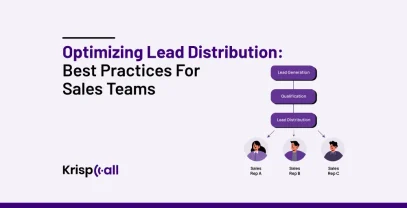Did you know you can sell your products directly and create strong customer bonds?
This strategy will help you gain valuable insights, engage your audience, and open new opportunities for everyone, from business owners to side hustlers and product lovers. In the endgame, this results in better sales! So, what is direct selling, and how can I start?
In this article, we will examine all the aspects of direct selling, including its definition, types, how to start it, how it differs from indirect selling, and its pros and cons.
Let’s dive into the world of direct selling! 🌟
🔑KEY HIGHLIGHTS
- Direct selling is a marketing technique in which a manufacturer or company sells its products to consumers or final customers without using distribution houses or agents.
- Direct selling is popular with businesses because this method can generate revenue and boost profits. However, it also requires significant time and effort, and success is not guaranteed.
- Direct selling operations can be scaled even in their early stages of development.
- Businesses that engage in indirect selling do not directly interact with customers; instead, they rely on the assistance of other entities in the selling process.
What is Direct Selling?
Direct selling is a marketing channel sales strategy whereby a manufacturer or company directly sells its products to consumers or final customers without using distribution houses or agents. It can be done through appointments in stores, online connections, or home sales parties, where customers feel they are being personally attended to when making their purchases.
A direct sales business requires a well-planned sales strategy or model to succeed. Direct sales business models focus on personal sales interactions, and a sales strategy is crucial for direct sales companies to achieve goals.
Here, a direct seller builds relationships with customers to drive sales and gather customer feedback to improve products. Also, identifying potential customers is the key to success in direct sales, as products are sold directly to customers.
Direct Selling Examples
Direct selling is based on the company-to-customer approach, which provides a personal touch, customer interaction, and genuine feedback to the customer.
Due to its appeal to people and technological advancement, direct selling is a suitable and popular operation among many individuals. Let’s look at some real-life examples of direct selling.
- Amway is a multinational company specializing in health, personal care, and home products. It is a prime example of a direct-selling company.
- Avon: It is famous for its vast range of cosmetics and skincare products in the beauty category.
- Herbalife: Delivers premier specialty products, nutritional supplements, and services to consumers for healthy living.
- Mary Kay: Best known for its makeup and beauty products, including lotions, creams, and makeup, often marketed through sales parties in people’s homes.
- Tupperware: Specializes in producing and providing various kitchen storage solutions, including gourmet items usually marketed through home parties/demonstrations.
📖Also read: What is Consultative Selling? A Complete Guide
Types of Direct Selling
There are various direct sales types, including one-on-one and party plan sales, and channel sales strategies are tailored to specific sales channels and approaches. The thing is, One-on-one sales (Single-Level Direct Selling) involve personalized interactions with customers, while party plan sales involve selling to groups of people.
And people often mix up those with each other. To understand each type of direct selling, let’s take a look at them:
1. Single-Level Direct Selling
Single-level direct selling is the most elementary form of direct sales strategy, as it involves a chain with only one link. Here, independent sales personnel are involved in a direct distribution channel where they directly sell the products and are paid a commission on the number of products they sell.
Although they work for the companies, the sales representatives are independently responsible for buying inventory, usually at a lower price than customers’, and reselling it to customers, taking the difference as profit. Here’s how things are done in this type of approach:
- Sales representatives work independently.
- Commission-based earnings.
- Working hours and methods are flexible when fully integrated working hours and various methods are combined.
2. Multi-Level Marketing (MLM)
Multi-level marketing, also known as MLM, is a direct selling approach to management in which the salespeople in the chain derive their revenues from actual sales and commissions earned from the sales made by other sales representatives that they recruited in the company.
This creates a structure of management where the representatives can sell and earn money additionally by managing other salespersons below them. Companies like Amway and Herbalife are well-known examples of MLM businesses.
- Earnings are also from direct personal sales of the products, and sales are made through the individuals the company recruits into the team.
- New policies are always offered as an attractive incentive to recruit new representatives.
3. Party Plan Direct Selling
Party-plan direct selling involves staging an event where the salesperson presents the products and prescriptions to a group. Such parties establish a social and convenient environment where people can view, touch, and taste products before purchasing them.
The sales representative has sales-related earnings and is paid based on the salespeople’s earnings during the party.
- Increasing sharing or social, interactive sales environment
- Demonstrations and product sampling
Here, another type is commission-based earnings from the sales of products through parties, in which the company creates its party to sell the products.
How to create a Direct Sales model?
To build a direct sales model, you need to develop a model wherein your team directly sells the products to the customers or a system where your team acquires the leads right through to the actual sale. Here are some steps:
- Define Your Target Market: Determine the specific characteristics of consumers you want to target and set individualized sales strategies that meet their expectations.
- Develop A Sales Strategy: Describe your sales planning objectives and strategies, target consumer personas, and distinctive selling points. Decide on the specific type of sales channels or techniques that you will use to communicate your message effectively to the intended target group.
- Create A Sales Process: It is also vital to include steps implemented in the sales sector to provide a concrete structure and methodology to follow throughout the selling process, starting from qualifying the leads and ending with making the sale.
- Train Your Sales Team: Train and develop your sales team into productive workers with all the skills, knowledge, and tools needed to deal with clients.
- Implement Lead Generation Tactics: You should also implement effective lead generation techniques, such as content marketing, emails, and social media advertising. These techniques will be crucial for attracting and connecting potential buyers.
- Track and Analyze Your Results: You must also conduct a sales analysis using sales tracking tools. This entails using tools to assess overall performance and make the right decisions about changes required during the selling process.
Hence, the following are the steps you can apply to develop a dependable direct sales model that you can depend on to create better relations with your clients and establish higher sales revenues, thus setting yourself as the superior company in your given market.
Pros of Direct Sells
1. Direct Interaction with Customers
Personal selling permits the establishment of interpersonal relations with buyers and helps the sellers develop a customer-centric culture. Such an approach may also increase customers’ confidence, loyalty, and satisfaction with the company’s products.
Example: Mary Kay consultants are always in contact with their customers and often act as skincare and makeup advisors, which creates a great relationship with them.
2. Immediate Feedback
Through direct selling, business people can react quickly if they feel that a particular business level is unsatisfactory. This assists in timely dealing with issues and in improving goods or services where applicable on consumer feedback.
Example: Salespeople, especially in Avon, can quickly tell how potential clients feel about new products during home calls or parties.
3. Full Control Over the Sales Process
Sellers can control how they want to make their products appear or how they want to sell them. This includes determining the correct prices and promotion policies and maintaining appropriate standards of customer relationship.
Example: Selling Tupperware needs different strategies; therefore, Tupperware consultants often change the demonstration content according to the targeted clients.
4. Enhanced Brand Loyalty
Direct selling helps build relationships that can positively impact brand identification, which is very important. Brand engagement is the key to customer loyalty since people tend to stick to using brands with which they are affine.
5. Flexibility and Independence
The nature of work being done under direct selling is incredibly flexible regarding work hours and the workplace. This is especially beneficial for those with work and other activities requiring their time.
Cons of Direct Sells
1. Scalability Challenges
Direct selling operations can indeed be scaled even in their late stages of development. As the company grows, one difficulty that first arises is sustaining similar levels of personal interactions and sales control.
2. Time and Effort Intensive
Customers’ relationships with direct sellers demand time, effort, and considerable money. This can be challenging, especially for those monitoring the business alone.
3. High Initial Rejection Rate
Even with good intentions, most direct sellers realize that there is usually a very high probability of refusal in the first instance since not everyone will be fascinated with the products or the selling method. This can dishearten new sellers, who are pressed to undertake risky operations in the search for better profits.
4. Limited Market Reach
While indirect selling is widespread, direct selling encompasses a more limited number of markets where a firm sells directly to customers. Most dealers’ core sources of customers are their circle of friends, family, and close ones, as well as their environment, which inhibits development.
5. Perception Issues
Direct selling can be defined as selling products directly to customers in an informal way using a face-to-face approach; however, certain negative attitudes towards direct selling exist, such as being aggressive or a pyramid selling system. Social biases are hard to change, so becoming free from such perceptions challenges direct sellers.
📚Also read: What Is Tech Sales, and How Can You Break Into It?
What are the direct sales strategies to close the deal?

Direct sales are all about building relationships and trust with your prospects. While many strategies can be used for it, there’s a set that can be followed blindly. By following these strategies, you’ll be well on your way to closing more deals and growing your business.
- Understand Your Product And Its Value: Anyone aspiring to sell what they offer cannot do so without detailed knowledge and comprehension of what they are selling. Understand what this involves, such as the features and benefits of your product and just how it improves your customer’s life.
- Build Rapport With Your Prospects: Statistical evidence shows that consumers develop long-term relationships with organizations and purchase goods and services from those they know and understand. Sometimes, it’s essential to take the time to initiate conversations about their needs and goals and listen to them.
- Ask Open-Ended Questions: If your prospects want to feel valued by your business, ensure they have the opportunity to comment by using probing questions. It is helpful for you to read through the outlines and help you figure out what their needs are so you can adjust your proposal appeal to them.
- Use Storytelling: The human mind is always fascinated by incidents and occurrences in the form of short narratives and long yammers, stories, and histories, but it cannot grasp facts and figures as they are projected. Cultivate the habit of telling your prospects success stories and case studies so that your prospects can mentally picture themselves using your product.
- Create a Sense of Urgency: People are naturally more likely to act when there is a sense of risk. Consider implementing some kind of special promotion, such as limited-time savings or a free additional service, to force a decision from the prospects.
- Follow-up: Call your prospects later to remind them of the service provided by your company. Inform them, respond to and clarify any issues, and negate any arguments against them.
- Ask for the Sale: Lastly, remember a crucial step: asking for the sale. You should be straightforward in communication and rather self-assured in delivery. If you have been successful in building rapport, meeting their needs, appealing to their emotions, and needing to act fast, you will very likely get a positive response from the prospect.
Why do businesses love to use direct sales?
Direct selling is popular with businesses because this method can generate revenue and boost profits. Here are some reasons why companies prefer direct sales:
- Helps Deliver Personalized Customer Experience: Direct selling facilitates identifying consumers and their needs, wants, and preferences. Companies can use CRM solutions to interact with customers and offer relevant solutions to strengthen client-company ties.
- Assists With Better Sales Conversion: Direct selling, therefore, allows the potential buyer to take a closer look at what a business has to offer, thereby increasing the likelihood of their making the purchase.
- Gives Better Control Over Sales Process: In direct selling, complete control of the sales process, which includes lead generation, sales closing, etc., is directly with the business.
- Helps Improve Sales Efficiency: By automating certain aspects of sales processes and integrating sales functions, businesses can also optimize their sales processes and improve their sales effectiveness. This means companies can increase productivity, save time, and minimize effort.
- Assists in Adaptability to Market Changes: The personnel of direct sales teams are well-prepared for working in dynamic conditions and adopting strategies suitable for changing customers’ needs. Such agility enables providing competitive service and a seamless response to emerging business trends.
- Helps Create Stronger Customer Relationships: Establishing face-to-face contacts frequently helps significantly when dealing with long-term customers. This will translate to more sales, customer loyalty, and better customer retention and loyalty or lifelong customer value.
- Contributes to Community Building: Direct selling usually involves creating a group of audiences of loyal customers and product distributors. This dials down the social aspect and creates a strong sense of community that benefits the business’s clients.
By realizing such advantages, firms can seek increased revenue streams, better serve clients, and enhance the effectiveness of selling strategies relying on direct selling.
Conclusion
Direct selling is a powerful and effective business model offering numerous benefits and opportunities for companies and individuals. By understanding its advantages, examples, and types, salespeople and businesses can achieve their financial and professional goals.
The direct-selling business model is still viable and vibrant, and businesses can make informed decisions about pursuing opportunities in this field if they are adequately informed.
As a closing note, we must remember that direct selling will adapt as technology and consumer preferences evolve, maintaining its relevance in the modern economy.





